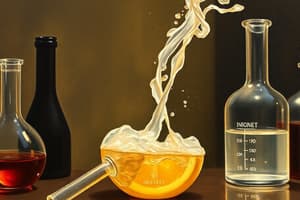Podcast
Questions and Answers
Was passiert bei der Dissoziation von Natriumhydroxid in Wasser?
Was passiert bei der Dissoziation von Natriumhydroxid in Wasser?
- Es dissoziiert vollständig in Na+ und OH-. (correct)
- Es dissoziiert nur teilweise.
- Es reagiert mit anderen Ionen, um ein Salz zu bilden.
- Es entsteht ein Oxoniumion.
Was ist die Aufgabe der Säurekonstante?
Was ist die Aufgabe der Säurekonstante?
- Die Messung der Konzentration einer Base.
- Die Trennung von Wasserstoff- und Hydroxidionen.
- Die Bestimmung der Stärke einer Säure. (correct)
- Die Berechnung der molaren Masse einer Substanz.
Welche Eigenschaft hat Ammoniak in wässriger Lösung?
Welche Eigenschaft hat Ammoniak in wässriger Lösung?
- Es ist eine starke Base.
- Es dissoziiert vollständig in Wasser.
- Es reagiert mit Wasserstoffionen, um ein Salz zu bilden.
- Es liegt größtenteils undissoziiert vor. (correct)
Wofür wird die Titration verwendet?
Wofür wird die Titration verwendet?
Was ist ein Lewis-Säure?
Was ist ein Lewis-Säure?
Was ist ein Proton?
Was ist ein Proton?
Was ist ein pH-Wert?
Was ist ein pH-Wert?
Was ist ein Indikator?
Was ist ein Indikator?
Was ist ein Ampholyt?
Was ist ein Ampholyt?
Was ist eine starke Säure?
Was ist eine starke Säure?
Flashcards
Brønsted-Lowry Acid
Brønsted-Lowry Acid
A substance that can donate protons (H+).
Brønsted-Lowry Base
Brønsted-Lowry Base
A substance that can accept protons (H+).
pH Value
pH Value
Negative logarithm of the oxonium ion concentration; measures acidity/alkalinity.
Neutralization
Neutralization
Signup and view all the flashcards
Ampholyte
Ampholyte
Signup and view all the flashcards
Conjugated Acid-Base Pair
Conjugated Acid-Base Pair
Signup and view all the flashcards
Autoprotolysis
Autoprotolysis
Signup and view all the flashcards
Buffer
Buffer
Signup and view all the flashcards
Oxonium Ion
Oxonium Ion
Signup and view all the flashcards
Lewis Acid
Lewis Acid
Signup and view all the flashcards
Study Notes
Säure und Base nach Brønsted-Lowry
- Ein Protonendonator (Säure) ist ein Stoff, der Protonen abgeben kann.
- Ein Protonenakzeptor (Base) ist ein Stoff, der Protonen aufnehmen kann.
- Beispiel für eine Säure: Salzsäure (HCl) gibt in Wasser ein Proton ab: HCl + H2O → H3O+ + Cl-
- Beispiel für eine Base: Ammoniak (NH3) nimmt in Wasser ein Proton auf: NH3 + H2O → NH4+ + OH-
Proton und pH-Wert
- Ein Proton ist ein H+-Ion, das bei Säure-Base-Reaktionen übertragen wird.
- Der pH-Wert ist der negative dekadische Logarithmus der Oxoniumionenkonzentration.
- Beispiel: Reines Wasser hat einen pH-Wert von 7, da [H3O+] = 10^-7 mol/L
Neutralisation und Indikator
- Neutralisation ist die Reaktion zwischen einer Säure und einer Base, bei der Wasser und ein Salz entstehen.
- Beispiel: HCl + NaOH → NaCl + H2O
- Ein Indikator ist ein Farbstoff, der seine Farbe in Abhängigkeit vom pH-Wert ändert.
- Beispiel: Lackmus ist rot in saurer und blau in basischer Lösung
Ampholyt und konjugiertes Säure-Base-Paar
- Ein Ampholyt ist ein Stoff, der sowohl als Säure als auch als Base reagieren kann.
- Beispiel: Wasser (H2O) kann sowohl Protonen abgeben als auch aufnehmen.
- Ein konjugiertes Säure-Base-Paar besteht aus einer Säure und der aus ihr durch Protonenabgabe entstehenden Base.
- Beispiel: HCl/Cl- oder NH4+/NH3
Autoprotolyse, Puffer und Säure-Base-Stärke
- Autoprotolyse ist die Selbstionisation des Wassers.
- Beispiel: H2O + H2O ⇌ H3O+ + OH-
- Ein Puffer ist eine Lösung, die den pH-Wert bei Zugabe von Säuren oder Basen nahezu konstant hält.
- Beispiel: Essigsäure/Acetat-Puffer
- Starke Säuren und Basen dissoziieren in wässriger Lösung vollständig, während schwache Säuren und Basen nur teilweise dissoziieren.
Oxoniumion und Hydroxidion
- Ein Oxoniumion (H3O+) ist ein protoniertes Wassermolekül.
- Beispiel: Entsteht bei der Dissoziation von HCl in Wasser: HCl + H2O → H3O+ + Cl-
- Ein Hydroxidion (OH-) ist ein Ion, das bei der Dissoziation von Basen entsteht.
- Beispiel: Bei der Dissoziation von NaOH in Wasser: NaOH → Na+ + OH-
Säure- und Basenkonstante
- Die Säurekonstante (KS) ist ein Maß für die Stärke einer Säure.
- Beispiel: KS(HCl) = 107 (sehr starke Säure)
- Die Basenkonstante (KB) ist ein Maß für die Stärke einer Base.
- Beispiel: KB(NH3) = 1,8 × 10-5 (schwache Base)
Titration und Lewis-Säure
- Titration ist eine Methode zur Bestimmung der Konzentration von Säuren oder Basen.
- Beispiel: Titration von HCl mit NaOH zur Bestimmung der HCl-Konzentration
- Eine Lewis-Säure ist ein Elektronenpaarakzeptor in der Lewis-Säure-Base-Theorie.
- Beispiel: AlCl3 kann ein freies Elektronenpaar aufnehmen
Studying That Suits You
Use AI to generate personalized quizzes and flashcards to suit your learning preferences.




